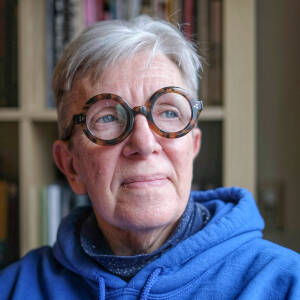Fazal Sheikh's Common Ground
Sue and I squeezed in time to see Fazal Sheikh's work at the art museum this morning. His work is not merely photography, but a lifelong dedication to people who have been dispossessed and rendered invisible, and a lifelong commitment to telling their stories.
What is crucial about his work is that he develops relationships with the people in his photographs. He does not "capture" the images. He meets the people, talks with them, hears them--no matter how painful it is to hold and hear their stories. Then when he posts the photographs, he includes their names--because that is a form of honoring them; he includes their stories next to the photographs; and he allows them to collaborate with him on their images. They get to choose how they will be depicted. Some choose for him to show only the backs of their heads. He makes extra effort to listen to women's stories, almost all of which include rape and physical abuse, and he allows the women to decide how he will represent them and how much of their stories he will tell.
I think when we are photographing people who have as much privilege and power as we do, it is not necessary to observe all these considerations, but I do feel that when we are photographing people with less privilege and power, it is worth asking ourselves if we are objectifying them, if we are abusing or exploiting them, if the purpose of the photograph is to honor and respect them or to glorify ourselves as photographers or observers.
What Fazal Sheikh is doing is, in my books, ethical social documentary photography, political photography, photography that is one act of love and courage after another. This is what I aspire to. I'll turn comments back on because I think it's important to be able to speak with each other about this, but I may be unable to respond for a while.
Update: I have great respect for street photography, and there is a huge difference between street photography and social documentary photography of people whose existence is tenuous. Sheik's subjects are refugees who have suffered trauma unimaginable to most of us. Their lives are uncertain and their future--if there is a future for them--involves more displacement and dispossession. Part of the exhibit is a collection of drawings made by children in the refugee camps, and every drawing shows bodies being blown apart, blood, and suffering. Most of us living in western countries are so privileged that we never even see this level of suffering, but our governments are partly responsible for the suffering, so the documentation of the suffering is important. We need to know this suffering exists, and that our privilege and comfort is interwoven with the suffering. But how to go about documenting it? That is his question. I share that question tangentially as I work with unhoused people and women mourning the deaths of their children and grandchildren as a result of gun violence. What I admire about his work, and aspire to, is his relationships with the people on the other side of the lens, the respect he pays them, and the way he collaborates with the people in creating images of themselves. To my way of thinking, those considerations do not apply to street photography except when the subjects are people whose lives are in danger because of extreme poverty and trauma. Here he is, talking about his work, for about 3 minutes.

Comments
Sign in or get an account to comment.


